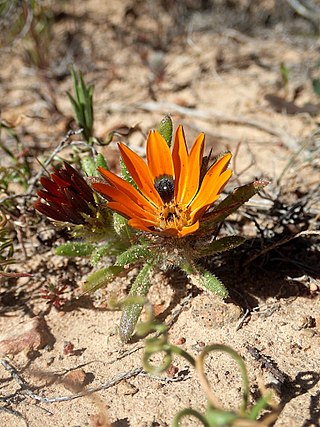
Conyza is a genus of flowering plants in the family Asteraceae.

Inula is a genus of about 80 species of flowering plants in the family Asteraceae, native to Europe, Asia and Africa.

The Gnaphalieae, commonly known as paper daisies, are a tribe of flowering plants in the family Asteraceae. It is most closely related to the tribes Anthemideae, Astereae, and Calenduleae.

Anisopappus is a genus of flowering plants in the family Asteraceae.

Distephanus is a genus of flowering plants in the family Asteraceae. It is described by American botanist Harold E. Robinson as having over 40 species and by David Mabberley as having only 34 species. These sources differ sharply in their description of the range of the genus. Robinson has it ranging throughout Africa and occurring also in India and China. Mabberley has it restricted to southeast Africa, Madagascar, and Mauritius. Plants of the World Online accepts 44 species native to sub-Saharan Africa, Madagascar, and south-central China.

Elephantopus is a genus of perennial plants in the daisy family (Asteraceae).
Artemisiopsis is a genus of flowering plants in the daisy family, Asteraceae.
Oligothrix is a genus of flowering plants in the groundsel tribe within the sunflower family.
Engleria is a genus of African flowering plants in the family Asteraceae.
Erlangea is a genus of African flowering plants in the family Asteraceae.

Gorteria is a genus of small annual herbaceous plants or shrubs that is assigned to the daisy family. It includes 12 species native to eastern and southern Africa, ranging from Ethiopia to South Africa. Like in almost all Asteraceae, the individual flowers are 5-merous, small and clustered in typical heads, and are surrounded by an involucre, consisting of in this case several whorls of bracts, which are merged at their base. In Gorteria, the centre of the head is taken by relatively few bisexual and sometimes also male, yellow to orange disc florets, and is surrounded by one complete whorl of 5–14 infertile cream to dark orange ray florets, sometimes with a few ray florets nearer to the centre. None, some or all of them may have darker spots at their base. The fruits remain attached to their common base when ripe, and it is the entire head that breaks free from the plant. One or few seeds germinate inside the flower head which can be found at the foot of plants during their first year. The species flower between August and October, except for G. warmbadica that blooms mostly in May and June. The species of the genus Gorteria can be found in Namibia and South Africa.
Iphionopsis is a genus of African flowering plants in the daisy family.

Melanthera, is a genus of perennial flowering plants in the family Asteraceae, native to North and South America, as well as Africa, Asia and Oceania, including Hawaiʻi.
Nicolasia is a genus of African flowering plants in the tribe Inuleae within the family Asteraceae.

William Philip Hiern was a British mathematician and botanist.
Roessleria is a genus of flowering plants in the sunflower family, Asteraceae. It includes five species native to southern Africa, ranging from Angola and Zimbabwe to South Africa.
Berkheyopsis echinus is a species of flowering plant in the sunflower family, Asteraceae. It is the sole species in genus Berkheyopsis. It is a perennial herb native to southern Africa, where it grows in Botswana, Namibia, and the Cape Provinces and Free State of South Africa.
Orbivestus is a genus of shrubs in the family Asteraceae, native to tropical Africa, the Arabian Peninsula and the Indian subcontinent. Its species were formerly placed in the genus Vernonia.
Vernonioideae is a subfamily of the sunflower family, Asteraceae. It includes seven or more tribes, some of which contain subtribes.








